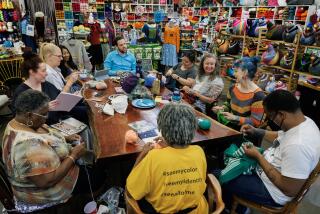These Knots That Bind Them
- Share via
From a plastic bag, Gerri Johnson-McMillin removed a stylized Styrofoam heart, about the size of a basketball. In the V of the heart, she had carved a hollow. “I have a new piece to show you guys,” the retired Cal State Northridge administrator told the assembled group. “It’s called ‘From the Bottom of My Heart.’ It’s going to be black inside,” she announced, showing off a spool of cord-like black waxed linen.
“Why black?” asked Rosalie Friis-Ross.
“Is the inside of your heart black?” asked Stephanie Plaut.
“I didn’t want just a valentine,” explained Johnson-McMillin. “I thought about doing a darker bluish, like an artery.”
“Maybe something bright and cheerful,” suggested Leah Danberg.
“I like black,” said Merrill Morrison.
“But the title is ‘From the Bottom of My Heart,’ ” reminded Friis-Ross.
“You guys,” Johnson-McMillin said, “I’m just trying to get into color. Remember?”
It was a rare moment of controversy--if you can even call it that--among this group of nine who get together once a month to knot. Knotting, according to Friis-Ross, the group’s founder, involves “a cord of waxed linen and putting knots on it in a way that it continues to coil and attaches to the previous row to create a sculpture.” The only tools required are fingers and scissors. Often a piece of Styrofoam or other object is used as a core. The coils wrap around the core, hugging the surface. In the end, the core is either removed or hidden under a dazzling shroud of tactile coils.
While knotting is a highly specialized method of basket-making, using the term “basketry” to describe this art is unfortunate, said Friis-Ross. “It’s just a word we have. We can’t seem to find the right word.” The word “basket,” suggests “a handle and an opening. These are totally different.”
*
Indeed, it’s no easy task to describe this work, something Morrison has discovered. “I always carry slides of my work because when people ask me what I do, there’s no way to explain it.” Friis-Ross, who has been teaching basketry at Otis College of Art & Design and at area prisons for 16 years, started the group in 1991 for several reasons. “So I wouldn’t be abandoning my students,” she said. “It’s hard to do this by yourself. You need interaction and a sense of community.”
For this month’s gathering, bowls of popcorn and Japanese soybeans, shared the table with spools of brightly colored waxed linen--ranging from the width of thread to thicker cords--and partially formed “baskets” such as Morrison’s vibrant “A Spot of Tea,” a black teapot with colorful beaded spots, and Norman Sherfield’s “Sentinel,” an abstract figure built around several rocks.
Sherfield, a word processor for a law firm and the lone male of the group, knots around all sorts of objects. He has used matches, nails, bottle caps, a screwdriver, a ball from a McDonald’s play area, even his daughter’s toys. “Usually, when she’s done with them,” he said. “I’ll knot over just about anything.” As if to dispel any doubts about this claim, on this night, he also brought a doll’s head with a piece from an Erector Set as a crown. Cascading from the crown were multicolored coils. “I’m going to knot over the whole thing,” he announced.
“It looks spooky,” said Johnson-McMillin, “. . . like Chucky.”
A little revenge, perhaps, for the ribbing she took for her black heart?
*
At one point, there were twice as many people in the group. But not everyone was cut out for an evening of knotting, or made the cut. “We’re serious,” said Morrison of the group’s work. “Instant gratification is not the answer,” Plaut concluded.
Among the reasons for the longevity of the group, aside from their personal commitment to knotting (a skill referred to in alternating breaths as “meditative” and “maddening”), Friis-Ross points to “an incredible chemistry” among the members. It helps that there’s a man in the group. “We don’t get too hormonal or catty,” Morrison said. “If we do,” said Johnson-McMillin, “Norman gets catty with us.”
There’s another key to their nearly 10-year union. “We don’t spend a lot of personal time together,” said Friis-Ross. But they do travel to shows together. In November, for instance, many of them will attend the Sculptural Objects Functional Art show in Chicago. In addition to exhibiting work at the show, there will be a book-signing of “Baskets: Tradition & Beyond” (Guild Publishing), a coffee-table book coming out next month in which many of these knotters are featured.
Many also show their work, which retails between several hundred and several thousand dollars, at the same galleries, including Del Mano in Brentwood, whose principals authored the book. “People are always taken aback by the beauty of the work,” said Jan Peters, one of Del Mano’s owners. They say, ‘I didn’t know this kind of work was being done.’ It’s a well-kept secret.”
“If only we could think of a different word than ‘basketry,’ ” said Friis-Ross, “we would be so much farther.”
More to Read
The biggest entertainment stories
Get our big stories about Hollywood, film, television, music, arts, culture and more right in your inbox as soon as they publish.
You may occasionally receive promotional content from the Los Angeles Times.










